The 2021 Ford F-150 may look a lot like the outgoing truck, but it has been given a hugely improved interior, lots of fun gadgetry and a hybrid powertrain called PowerBoost. Here’s a first look at what it was like to briefly drive the newest version of America’s best-selling pickup. It’s leveled up.
(Full Disclosure: Ford invited me to its Michigan Proving Grounds near Romeo, Michigan. I drove there from my home and realized upon my arrival — for the 100th time — that I drive a junkier car than 99 percent of car journalists, as the lot was filled with snazzy press vehicles. Ford fed me brisket in its cafeteria and later handed me a free notebook to jot down my thoughts on the company’s new pickup.)
The new Ford F-150 comes with lots of engine choices. There’s a naturally aspirated 3.3-liter V6, a 2.7-liter turbocharged V6, a 3.5-liter turbocharged V6, a 3.0-liter turbodiesel and a 5.0-liter naturally aspirated V8. These are all familiar engines, though — new for 2021 is a 3.5-liter hybrid V6.
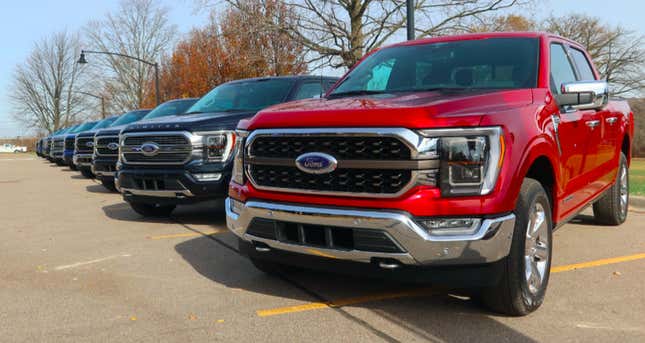
That hybrid makes 430 horsepower and an absurd 570 lb-ft of torque, sending it all through a 10-speed automatic transmission. The hybrid system also lets the internal combustion engine act as a generator, feeding a battery connected to power outlets in the bed of the truck, should you want to use power tools. It’s one of many of the new truck’s gadgets, which include an electronically folding shifter that accommodates an interior work surface and a flat-folding “sleeper seat” option, among others.
That’s really the story of the 2021 Ford F-150: It’s got lots of gadgets and a new hybrid powertrain. It’s clever, really. And it’s also really nice, particularly on the inside.
2021 Ford F-150 Explained
The 2021 Ford F-150 looks like a prettied-up version of the 2020 model, but it’s actually all-new according to Ford. Though it still features an aluminum body on a steel frame connected to a leaf-sprung solid axle in the rear and a coil-sprung double-wishbone suspension up front, there’s a lot about the 2021 model that’s fresh. Especially inside and under the hood.
Let’s talk about the styling briefly. The truck looks familiar, but the simpler grille shape and headlights with C-shaped DRLs make for what I think is a cleaner front end than the outgoing model (whose grille jutted into the lights — I was never sold on that look). Ford says it focused a lot on aerodynamics, employing active shutters behind the grille and an active air dam below the front bumper (like the Ram 1500), lengthening the tailgate top, chamfering the back of the cab, optimizing the mirror shape and making a number of other tweaks to bring that vehicle’s drag coefficient down.
The big deal for 2021, though, is the hybrid system, which adds two electric motors, a small battery pack and power electronics to Ford’s 3.5-liter EcoBoost V6. Total horsepower is 430 and max torque is 570 lb-ft. That latter number is absurd.
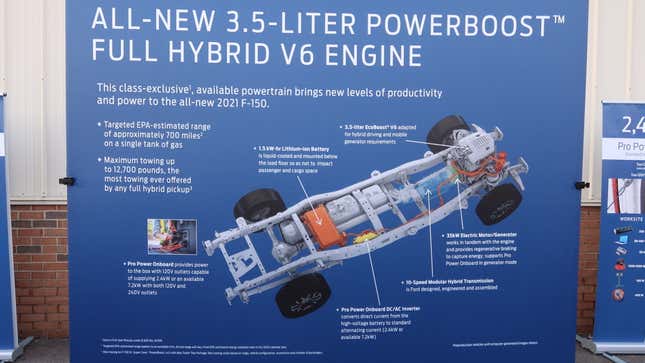
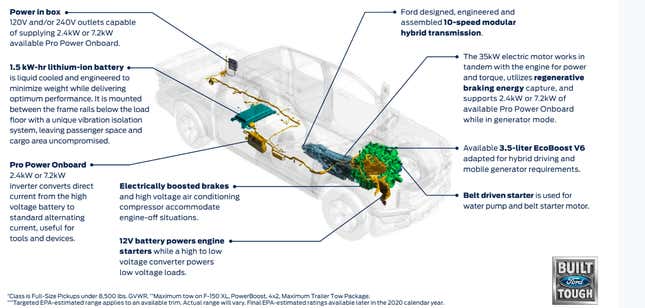
One electric motor is located on the FEAD (front end accessory drive), and is driven by the engine’s belt (this is known as a P0 hybrid system). The other is a 35 kW unit tucked between the engine and 10-speed transmission’s torque converter, hidden inside a unique bell housing (this is called a P2 hybrid system). A clutch between the engine and electric motor allows the latter to propel the vehicle while the engine is off.
The liquid-cooled battery pack uses a glycol-based coolant in the a/c “chiller” loop. That battery, a 200+volt, prismatic cell-containing pack, while only 1.5 kWh in capacity, is sizable. It spans nearly the entire distance between frame rails and sits above the exhaust and rear driveshaft. Here’s a look:
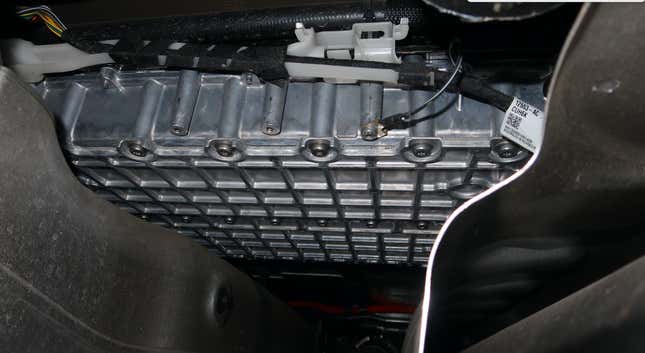
It’s worth noting that the hybrid system maintains the traditional 12-volt starter motor in order to ensure consistent engine starts in cold conditions. The belt starter-generator tends to do the majority of engine starts during normal driving, as it allows for more seamless start-stop events than the conventional starter.
Other changes include a new interior with a 12-inch screen in the center stack. Though it still maintains a big shift lever and some chunky, angular bits of trim, the interior looks decidedly less Tonka Truck-like than the outgoing model. The big screen lets the driver actuate an optional Pro Power Onboard system of electrical outlets in the bed of the truck to act as a supply for corded power tools.

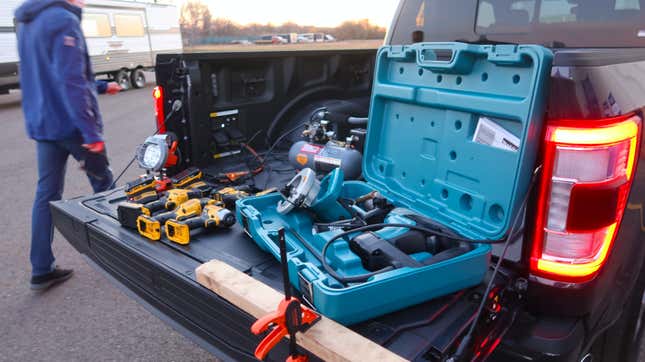
The new F-150 is a gadget truck. The outlets in the bed are just one example of many convenience features marketed to convey that this truck is meant for those who spend lots of time on a jobsite. There are also the flat-folding (well, 176-degree-folding*) Max Recline front seats, the aforementioned Interior Work Surface and a Tailgate Work Surface.

The 2021 Ford F-150 Comes With A Desk
The Interior Work Surface, available on bucket-seat-equipped trucks, includes an electrically folding transmission shift lever. With that out of the way, the center armrest flips forward to create a flat table, ideal for food, a laptop, a clipboard or whatever.

On split-bench-seat-equipped models, the center seat folds down, a button slides the work surface forward (revealing some cubbies and cup holders), and another button rotates the top section of that sliding plastic rectangle:

Under the base cushion of that center seat is lockable bin:

The Tailgate Work Surface seems like a bit of a gimmick. It’s basically a big piece of plastic on the inside of the tailgate with some rulers on it and places to put your phone, drink and pencil.
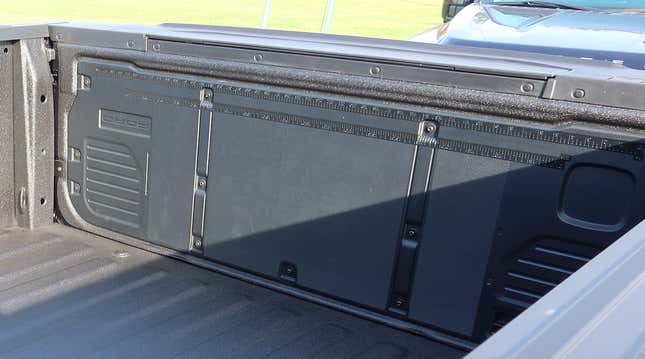
The Max Recline seats, available on Platinum, Limited and King Ranch trims, require folding up the rear seat bottom cushions. Then the front buckets can lean back, the lower cushion can rise and the upper back support can rotate a few degrees, yielding a nearly flat “bed.”
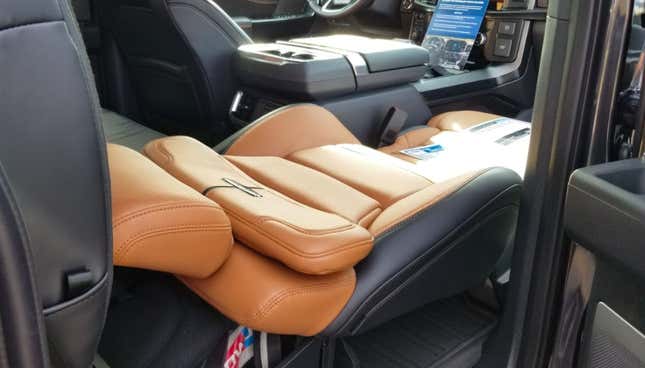
Ford made a little video that gets into the details of the Max Recline seats, should you feel so inclined — or should I say “reclined”:
What’s Good
I drove the new truck for only a few hours, and I have to say that this wasn’t enough time to draw conclusions about the ride or handling compared to the outgoing truck. What I can say is that the basic vehicle architecture is similar, and there have been no dramatic changes in these areas. The ride is still a bit unsettled when you hit a bump while turning, but that’s pretty much par for the course on anything with a solid rear axle.
What has seen a dramatic change is the interior. On higher trims, it feels top-notch. And while that may seem unsurprising for $70,000+ trucks, the reality is that the outgoing F-150 couldn’t compete with the Ram 1500's gorgeous cabin. The Blue Oval’s new cash-cow pickup really closes the gap with a more elegant design and higher quality materials.

The large expanses of silver trim surrounding the center stack, center console, and dash definitely give the truck a brawnier, perhaps less luxurious look than the Ram, but nonetheless, the truck feels significantly upscale. As soon as I sat down, the first thought in my mind was “Whoa. The F-150's interior is at the next level.”
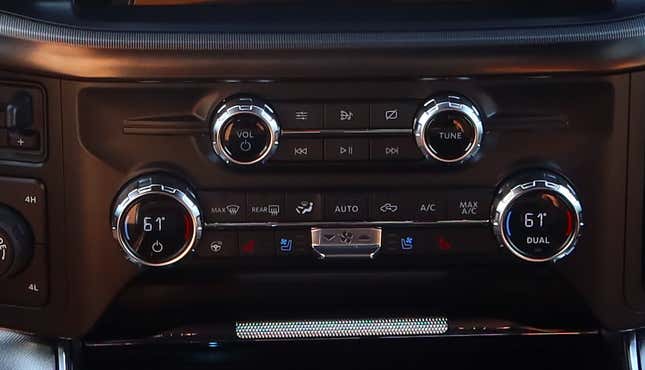
The switchgear is excellent. I’m as much a blower dial fan as the next person, but the chrome blower toggle switch on the F-150 is extremely satisfying to use, and I’m not even sure why. The volume, tune and cabin temperature knobs are great; I can appreciate Ford keeping these switches instead of bringing all these functions to that giant touchscreen.
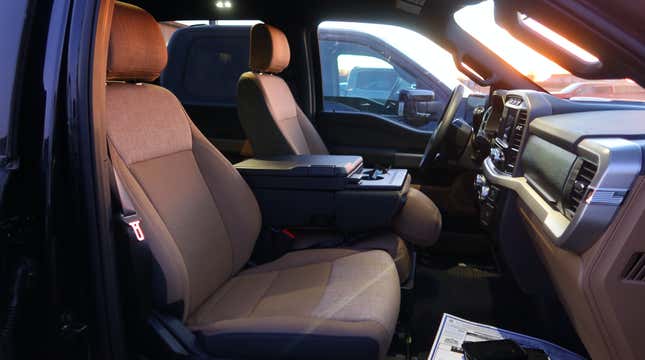
Even lower trim models offer decent interiors. Sure, some have fairly hard plastic trim in spots, but just look at the cool pattern on the tan split-bench seat above. The tan trim on the lower dash and doors, along with the column shifter, makes this my preferred interior choice, even if higher trim levels get the bigger screen and the nicer materials.
The interior work surface is cool enough. The shifter is a bit noisy when it folds, and I’d always be worried that it’d get stuck in that down position, no matter how much validation testing Ford says it’s done. Plus, I think I’d prefer a bit more center console storage to this feature, though if I were someone who frequently worked on-the-go, such a work surface could make life easier.
I just spent weeks working from a 1994 Chrysler Voyager minivan. Often, I rested the laptop on the steering wheel or I set it in my lap. It wasn’t comfortable, though I’m curious to know how comfortable I’d feel working on a laptop that was a bit off to the side, as it would be if I used the F-150's surface. I’d have to turn my body a bit; I wonder if, over time, I’d be inclined to just grab the laptop and place it directly ahead of me. I’ll have to test this when I have more time with the truck.
The Max Recline sleeper seat is great. It’s slow, and forgetting to fold it all the way back up yields an endless warning in the instrument cluster, but the thing is essentially flat, and I could easily sleep in those front seats comfortably. It’d be great if Ford offered rising leg rests so that one wouldn’t have to sleep with legs dangling off the end of the seat, but as it is, I’m a fan of this gadget.
The hybrid F-150 is powerful and quick, though there is some lag between pedal input and vehicle acceleration. It wasn’t obvious to me if it was turbo lag or the transmission’s downshift time that accounted for most of the delay, but it was there. Once the truck does accelerate though, it does so impressively. It’s never dramatic or loud; the motor simply moves the speedometer needle quickly and without a fuss, keeping the cabin surprisingly quiet.
The cabin becomes damn near silent as soon as the engine cuts off and the electric motor takes over propulsion duty. This didn’t happen frequently on my drive, only when coasting or lightly pressing on the accelerator pedal.
The 5.0-liter naturally aspirated V8 makes 30 horsepower fewer at 400, and it’s 160 lb-ft down at 410, but the soundtrack — and the fact that the V8 pickup weighs roughly 600 pounds less than its electrified counterpart — just makes the Five-O feel faster.
As I say in the video above, the V8 is the engine to get if you relish things like “joy” and “excitement,” though the 250-horsepower, 440 lb-ft 3.0-liter diesel, with its gobs of torque, might be a good call if you do lots of towing and care about “fuel economy” (I’m not sure why I’m using quotes at this point). The hybrid may make you happy if you want a good combination of speed, efficiency and refinement.
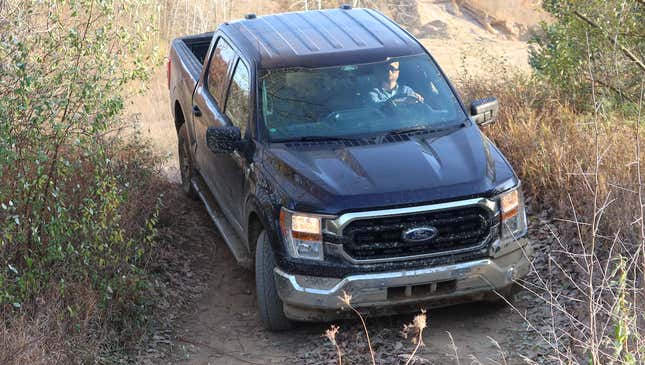
I took the F-150 off-road, and while I won’t say I did anything particularly difficult — and indeed, the truck’s low front fascia, running boards and big rear overhang would have prevented it from doing so — I will mention that the locking rear differential and traction control system gave the truck plenty of grip in mud, especially given that the tires aren’t particularly aggressive.
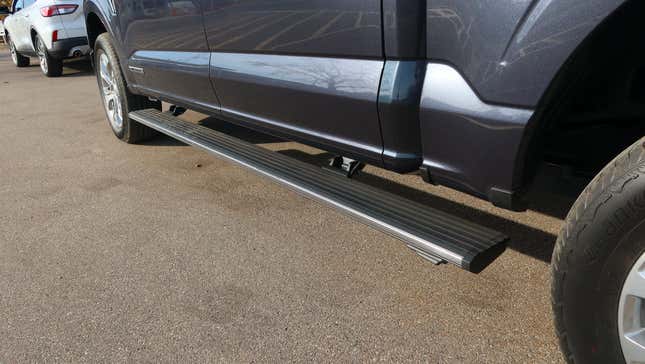
What’s Weak
The new F-150 is a solid truck, though Ford has left some low-hanging fruit dangling from the full-size pickup tree. First, the running boards—they are great. They lower as soon as one opens a door, or they can lower with the press of a button, offering easy access to the front of the bed. But my god are they loud. There’s really no reason for them to be that loud. Step into the F-150, close the door, and it immediately seems like the truck is raising its landing gear. It’s a bit silly.
Also silly is this pinch seam at the base of the driver’s door — a spot in my line of sight every time I alighted. As shown, there’s a rivet and what looks like some kind of adhesive connecting the two layers of aluminum.
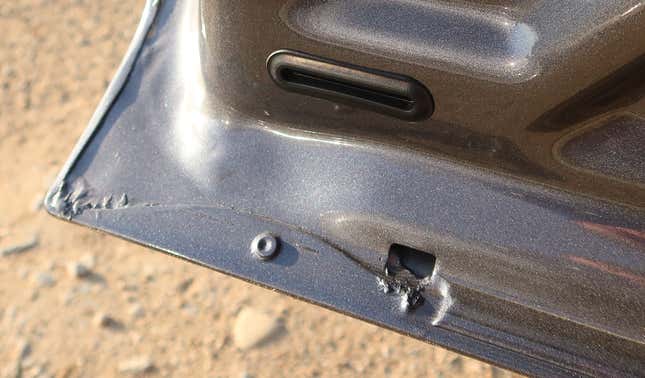
One of the trucks, shown above, had hideous adhesive blobs surrounding that seam, while another, shown below, looked much nicer. While Ford wants me to note that the trucks I tested are preproduction vehicles, I think that’s an excuse too often accepted by car journalists on press drives.
These press vehicles are specially prepared to be scrutinized by car reviewers; if there’s any time for an automaker to show the best versions of itself, it’s during a press launch.
Ford’s engineer did say he’d discuss this issue with his team, and to be fair, this sloppy surface isn’t really that big of a deal. Functionally, it changes nothing. But this falls under what some automakers call “perceived quality,” so it’s worth mentioning.
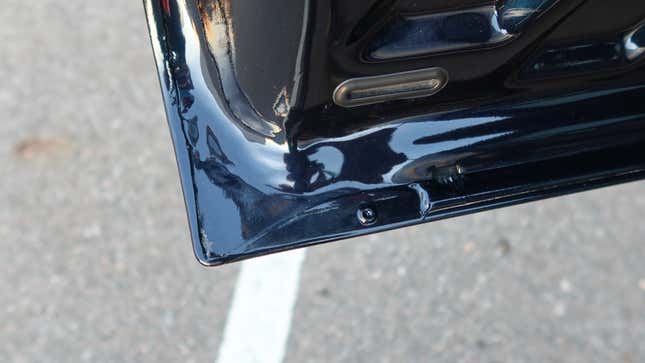
Another issue I noticed was door closure effort. This is actually a big deal in the world of automotive engineering, and there’s lots of testing done to make sure vehicles perform well in this metric. Indeed, one of the engineers at the F-150 event told me that the truck excels in the area of door-closure effort according to the company’s testing, but the reality is that in the real world, the trucks that I tested do not.
I felt that multiple trucks required far too much effort to shut the doors, often requiring me to reopen the closures and slam them shut.
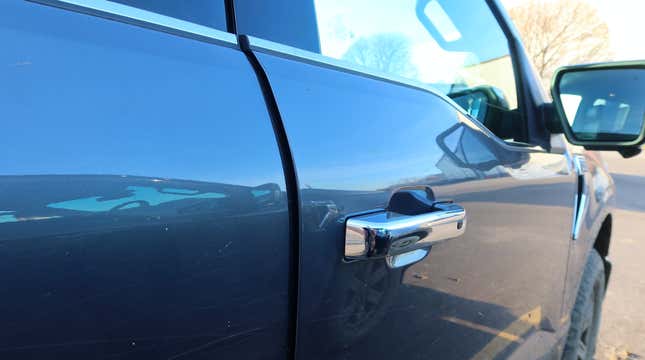
There’s a lot that goes into door closure effort optimization, including making sure that rubber exhaust flaps allow air to escape the vehicle quickly enough to prevent a high pressure in the cabin that would resist door closure. (I’ve written about these exhausters here). But something else that goes into it, and indeed a challenge for Ford according to one of the engineers on site, has to do with momentum, which is a product of not just the door’s velocity but also its mass.
The doors being aluminum creates a challenge for door closure effort, which, at least on the trucks I drove, was easily the poorest of any vehicle I’ve tested. I don’t check doors for closure effort when I review vehicles; the fact that I even took notice of this shows me there’s a problem, though I don’t know how much customers are going to care.
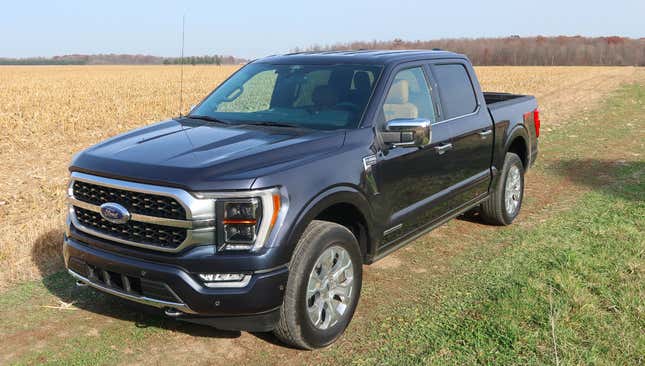
Verdict
The 2021 Ford F-150 is big, heavy and expensive, with the trucks I drove ranging from roughly $50,000 to $75,000. But if you can swallow that price, you’ll find that — especially on the higher-end models — the F-150's new interior, its useful gadgets and its range of powertrains make it a highly competitive pickup truck in damn near every category.
Updated (Nov 19, 2020 5:55 P.M. ET): Fuel economy for the hybrid model has been added to the spec box.
